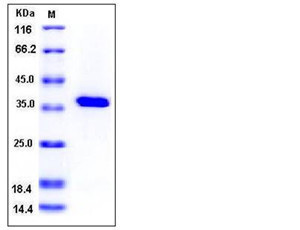Human PTP1B / PTPN1 Protein (His Tag)
PTP1B,PTPN1
- 100ug (NPP2241) Please inquiry
| Catalog Number | P10304-H07E |
|---|---|
| Organism Species | Human |
| Host | E. coli |
| Synonyms | PTP1B,PTPN1 |
| Molecular Weight | The recombinant human PTPN1consisting of 327 amino acids and has a calculated molecular mass of 38 kDa. |
| predicted N | Met |
| SDS-PAGE |  |
| Purity | > 95 % as determined by SDS-PAGE |
| Protein Construction | A DNA sequence encoding the human PTPN1 (NP_002818.1) (Glu 2-Asn 321) was expressed, with a polyhistide tag at the N-terminus. |
| Bio-activity | Measured by its ability to dephosphorylate a phosphotyrosine residue in an EGF receptor (aa988-998) phosphopeptide substrate, R&D Systems, Catalog # ES006. The specific activity is > 15 nmoles/min/μg. |
| Research Area | Cancer |Signal transduction |Protein Phosphorylation |Tyrosine Phosphatase |
| Formulation | Supplied as sterile 10 mM Hepes, 150 mM NaCl, 1 mM DTT, pH 7.5. 1. Normally 5 % - 8 % trehalose and mannitol are added as protectants before lyophilization. Specific concentrations are included in the hardcopy of COA. |
| Background | PTP1B, also known as PTPN1, belongs to the protein-tyrosine phosphatase (PTP) family. PTPs catalyze the hydrolysis of the phosphate monoesters specifically on tyrosine residues. Members of the PTP family share a highly conserved catalytic motif, which is essential for the catalytic activity. PTPs are known to be signaling molecules that regulate a variety of cellular processes including cell growth, differentiation, mitotic cycle, and oncogenic transformation. PTP1B contains 1 tyrosine-protein phosphatase domain and is expressed in many tissues. PTP1B is localized to the cytoplasmic face of the endoplasmic reticulum. PTP1B was also reported to dephosphorylate epidermal growth factor receptor kinase, as well as JAK2 and TYK2 kinases, which implicated the role of PTP1B in cell growth control, and cell response to IFN stimulation. |
| Reference |
